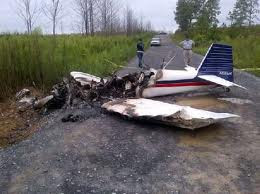Most of us are aware of the devastation a bird strike can have on an aircrafts structure or engines. But what about an insect? Or a few ice crystals? A surprisingly trivial substance can bring down even the largest aircraft.
 Even a small amount of moisture can wreak havoc as in the loss of a $1.4 billion stealth bomber. This crash, the most expensive in the history of military aviation, was the result of not switching on the pitot heat system prior to air data calibration.
Even a small amount of moisture can wreak havoc as in the loss of a $1.4 billion stealth bomber. This crash, the most expensive in the history of military aviation, was the result of not switching on the pitot heat system prior to air data calibration.
All avionics systems rely on devices called "pitot tubes." These measure the force (impact) of oncoming air. The "pitot-static" system compares this impact pressure to the neutral (static) air pressure. The information is fed to three of the most critical instruments: Airspeed, Altitude and Rate of Climb. A blocked static port affects all three instruments, while the pitot tube itself will only involve airspeed.
The simplicity of the pitot tubes makes them vulnerable to blockages. The elaborite system of avionics, gauges and computers can be deceived by any number of blockages. Dead insects, mud wasp nests, and ice are the most common.
The most hideous aspect of this malfunction is the way a pilot, or even worse, computer, can be fooled. The flight instruments can provide wrong or conflicting information with a potentially tragic outcome. A pitot system failure is considered to be the worst possible malfunction of an aircrafts avionics.
 Even a small amount of moisture can wreak havoc as in the loss of a $1.4 billion stealth bomber. This crash, the most expensive in the history of military aviation, was the result of not switching on the pitot heat system prior to air data calibration.
Even a small amount of moisture can wreak havoc as in the loss of a $1.4 billion stealth bomber. This crash, the most expensive in the history of military aviation, was the result of not switching on the pitot heat system prior to air data calibration.
An X-31A crashed in 1995 after a pitot tube was blocked by ice. Many military aircraft are too unstable to control without automated avionics. In some situations the plane is not recoverable.
Austral Lineas Aereas Flight 2553 was lost, along with 74 lives, when a pitot tube froze solid. The DC-9's instruments fooled the pilots into believing the plane was stalling. Pilots are trained to trust the instruments and computers, especially in darkness and poor weather. Spatial disorientation prevented the pilots from making proper decisions. Structural failure was the result of adding full power and lowering the flaps at high speed. Flight 2553 impacted the terrain at 1,200 kph.
In 1996, Birgennair Flight 301 crashed shortly after takeoff. Mud wasps built a nest in one of the Boeing 757's pitot tubes. The captains airspeed indicator showed 350 knots and triggered the autopilot to pull up and reduce power. The actual airspeed was much slower. The pilots heard contradictory overspeed and stall warnings. Although the co-pilots seperate pitot system was working the pilots could not know which to believe. The stall warning was very real but was ignored to withing 8 seconds of the ground. 183 people were killed. Ground crews could have saved Flight 301 by installing pitot tube covers while it sat idle.
That same year Aero Peru Flight 603 was lost because ground crews failed to remove a piece of duct tape from the static ports on another 757. The computers issued overspeed, underspeed and "too low, terrain" warnings. Again, the pilots had no way of knowing which warnings were correct. They asked Air Traffic Control for the correct airspeed and altitude. With this information they confidently flew the aircraft into the ground. All 70 on board were killed.
This crash illustrates just how deadly a failed pitot-static system can be. The simple devices are the source of the entire system. The failure of even one of the two or three can circumvent the whole concept of redundancy. Besides feeding nformation to the gauges and computers, the faulty readings were also relayed to the air traffic controllers. The aircrafts computer fooled the controllers into confirming horrifically wrong speed and altitude.
It's hard to believe how many aircraft and lives have been lost to such trivial events. It's unsettling to realize they wil not be the last.

Ulasan
Catat Ulasan